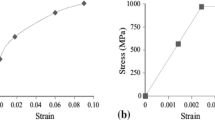Abstract
The effect of crack bridging reinforcing members on the growth of a transverse fatigue crack in an aluminium alloy sheet has been examined. The specimens have been subjected to zero tension cyclic loading applied in the reinforcement direction. In the case of some specimens initial tensile stresses were developed in the substrate aluminium sheet by the reinforcing members. In other cases initial compressive stresses were developed. Fatigue crack growth rates in the unreinforced aluminium alloy sheet were also determined. In the case of both types of reinforced structures the reinforcing elements suppressed the growth of fatigue cracks compared with the unreinforced material. This effect was particularly marked in the case where the substrate aluminium sheet was prestressed in compression-the crack growth rates approaching zero as the peak applied tensile strain approached the value of the initial compressive pre strain.
The mechanisms whereby fatigue crack growth in the substrate aluminium sheet is suppressed are discussed and their effectiveness related to the behaviour of the unreinforced material by comparing crack growth rates in terms of effective stresses intensity factors.
The compressive stresses were developed in the substrate sheet using two part core/tube reinforcing members. The cores were held in residual tension with the rest of the structure in corresponding compression. The prestress condition appears to be achievable with negligible weight penalty in structures of appreciable size where the engineering requirement is to limit the deformation of a structure under load. Where increased elastic deflections and correspondingly higher stresses are acceptable, reductions in structure weight together with an improved resistance to fatigue crack growth compared with the unreinforced material appear possible.
The cores are designed not to be fracturable as a consequence of tensile deformations of any magnitude applied to the composite structure. Hence, they provide a residual load bearing capability and also inhibit crack extension in the fracturable part of the structure under all conditions of tensile loading.
Résumé
On a examiné l'effet de pontage d'une fissure occasionné par des éléments de renforcement, dans le cas de la croissance de fissure de fatigue transversale dans une tôle d'alliage d'aluminium. Les éprouvettes étaient soumises à une sollicitation de traction cyclique pulsée appliquée dans la direction du renforcement. Dans le cas de certaines éprouvettes, des contraintes initiales de traction étaient développées dans la tôle d'aluminium servant de substrat directement par l'élément de renforcement. Dans d'autres cas des contraintes initiales de compression étaient développées. La vitesse de croissance de la fissure de fatigue de la tôle d'alliage d'aluminium non renforcée a également été déterminée. Dans les deux types de structure renforcée qui ont été examinés les éléments de renforcement suppriment la croissance de fissure de fatigue, quand on se compare au matériau non renforcé. Cet effet a été particulièrement marqué dans le cas d'une tôle d'aluminium pré-comprimée: dans ce cas, les vitesses de croissance de fissuration approchaient de 0 lorsque la déformation appliquée en traction approchait la valeur de la pré-déformation de compression initiale.
On discute les mécanismes par lesquels la croissance d'une fissure de fatigue dans un tôle d'aluminium peut être supprimée ainsi que l'efficacité de leur comportement dans le matériau non renforcé en comparant les vitesses de croissance de fissure en termes de facteur d'intensité de contrainte.
Les contraintes de compression étaient introduites dans la tôle de base en utilisant des éléments de renforcement constitués d'un tube et d'un noyau. Le noyau était maintenu en tension résiduelle tandis que le reste de la structure était amené en compression. Les conditions de précontrainte apparaissent réalisables avec une faible pénalisation en poids dans des structures d'une dimension déjà appréciable lorsque les exigences de la conception limitent la déformation de la structure sous contrainte. Lorsqu'on admet des déflexions élastiques plus importantes et des contraintes correspondantes plus élevées, il apparait possible d'obtenir des réductions dans le poids de la structure ainsi qu'une résistance accrue à la croissance d'une fissure de fatigue, par rapport à une structure non renforcée.
Les noyaux sont conçus de manière à résister aux déformations de traction appliquées à la structure composite. Dès lors, ils apportent un complément de résistance aux charges appliquées et empêchent l'extension d'une fissure dans la partie de la structure susceptible de se rompre, sous toutes les conditions de mise en charge.
Similar content being viewed by others
References
C., Laird and G.C., Smith, Philosophical Magazine 8th Series, 8 (1972) 847–857.
K.G., Kreider and K.M., Prewo, in Composite Materials, 4, Editors Broutman and Krock, Academic Press, New York (1974). See also A.A. Baker and D. Cratchley, Applied Materials Research 3 (1964) 215–222.
P.J.E., Forsyth, R.W., George and D.A., Ryder, Applied Materials Research 3 (1964) 223–228.
B., Harris, A.O., Ankara and M.A., McGuire, Journal of Physics D: Applied Physics 9 (1976) 365–372.
I.R., McColl and J.G., Morley, Journal of Physics D: Applied Physics 10 (1977) 599–616.
J.G., Morley, R.S., Millman and A., Martin, Journal of Physics D: Applied Physics 9 (1976) 1031–1047.
L.N. McCartney and P. Cooper, Computerised processing of fatigue crack propagation data, National Physical Laboratory, Report Materials Application 23 (1972).
J.P., Bentham and W.T., Koiter, in Mechanics of Fracture I. Methods of Analysis and Solutions of crack problems, Noordhoff International Publishing, Leydon (1973) 131–178.
P.C. Paris, in Fatigue—an international disciplinary approach, Syracuse University Press (1964) 107–132.
J.G., Morley and I.R., McColl, Engineering Fracture Mechanics 14 (1981) 1–25.
I.R., McColl and J.G., Morley, Philosophical Transactions of the Royal Society of London A, 287 (1977) 17–43.
J.G., Morley and I.R., McColl, Journal of Physics D: Applied Physics 8 (1975) 15–33.
R.T. Potter, Proceedings of the Royal Society of London 361 (19) 325–341.
Author information
Authors and Affiliations
Rights and permissions
About this article
Cite this article
McColl, I.R., Morley, J.G. Suppression of fatigue crack growth in aluminium alloy sheets. Int J Fract 18, 191–216 (1982). https://doi.org/10.1007/BF00032274
Received:
Issue Date:
DOI: https://doi.org/10.1007/BF00032274




